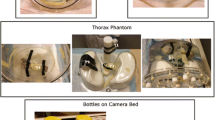Abstract
Elimination of errors due to poor attenuation correction is an essential part of any quantitative single photon emission tomography (SPET) technique. Attenuation coefficients (μTc) for use in attenuation correction of SPET data were determined using technetium 99m and cobalt 57 flood sources and using topographical information obtained from computed tomography (CT) scans and magnetic resonance (MR) images. In patients with carcinoma of the bronchus, the mean attenuation coefficient for 99mTc was 0.096 cm−1 when determined across a transverse section of the thorax at the level of the tumour by means of a 57CO flood source (13 patients) and 0.093 and 0.074 cm−1 as determined from CT scans for points in the centre of the tumour and contralateral normal lung, respectively (21 patients). In 18 patients with breast tumours, the mean attenuation coefficient for 99mTc was 0.110 and 0.076 cm−1 when determined from MRI cross-sections for points in the centre of the tumour and normal contralateral lung, respectively. This indicates significant overcorrection for attenuation when the conventional value of 0.12 cm−1 is used. A value in the range 0.08–0.09 cm−1 would be more appropriate for SPET studies of the thorax. An alternative approach to quantitative region of interest (ROI) analysis is to perform attenuation correction appropriate to the centre of each ROI (using topographical information derived from CT or MRI) on non-attenuation-corrected reconstructions.
Similar content being viewed by others
References
Bailey DL, Hutton BF, Walker PJ (1987) Improved SPECT using simultaneous emission and transmission tomography. J Nucl Med 28:844–851
Chang L-T (1978) A method for attenuation correction in radionuclide computed tomography. IEEE Trans Nucl Sci NS-25:638–643
Clarke LP, Leong LL, Serafini AN, Tyson IB, Silbiger ML (1986) Quantitative SPECT imaging: influence of object size. Nucl Med Comm 7:363–372
Inamdar R (1982) Quantitative single photon emission tomography using a rotating gamma camera system. MSc thesis, University of Surrey
Macey DC, Marshall R (1982) Absolute quantitation of radiotracer uptake in the lungs using a gamma camera. J Nucl Med 23:731–735
Rowell NP (1991) Hydralazine and tumour blood flow in man. MD thesis, University of Cambridge
Rowell NP, Flower MA, McCready VR, Cronin B, Horwich A (1990) The effects of single dose oral hydralazine on blood flow through human lung tumours. Radiother Oncol 18:283–292
White DR, Fitzgerald M (1977) Calculated attenuation and energy absorption coefficients for ICRP reference man (1975) organs and tissues. Health Physics 33:73–81
Author information
Authors and Affiliations
Rights and permissions
About this article
Cite this article
Rowell, N.P., Glaholm, J., Flower, M.A. et al. Anatomically derived attenuation coefficients for use in quantitative single photon emission tomography studies of the thorax. Eur J Nucl Med 19, 36–40 (1992). https://doi.org/10.1007/BF00178306
Received:
Revised:
Issue Date:
DOI: https://doi.org/10.1007/BF00178306




